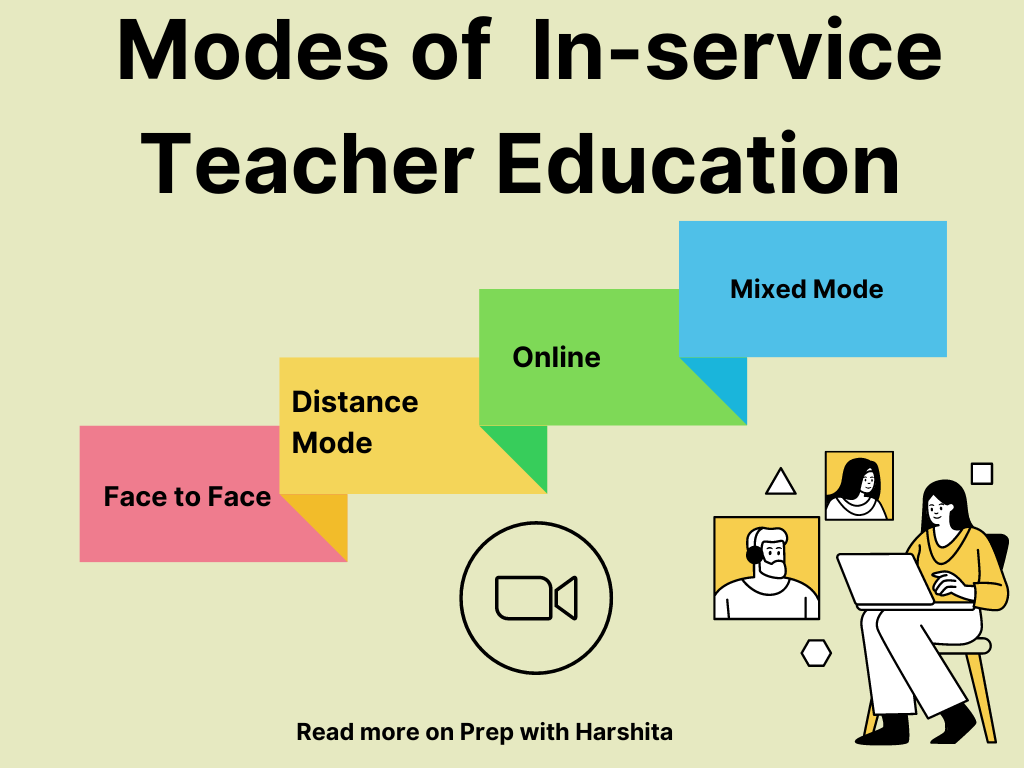Modes of in-service teacher education refer to the different delivery methods and formats through which professional development and training opportunities are provided to teachers.
Here are some common modes of in-service teacher education:
- Face-to-Face Mode: The face-to-face mode of in-service teacher education refers to traditional, in-person training and professional development sessions. These sessions are conducted in physical locations, such as schools, training centers, or conference venues. Teachers attend workshops, seminars, conferences, or training sessions where they interact directly with facilitators, experts, and other participants. Face-to-face mode provides opportunities for immediate feedback, networking, collaboration, and hands-on learning activities. It allows for personal interaction, question-and-answer sessions, and real-time discussions, fostering a sense of community and engagement among participants.
- Distance Mode: The distance mode of in-service teacher education involves providing professional development opportunities to teachers who are physically separated from the training provider. In this mode, educational materials, resources, and instructional support are delivered to teachers through various means of communication, such as mail, telephone, or broadcasting. Distance mode can include sending printed materials, recorded lectures, or educational videos to teachers, who can access and study the content at their convenience. Distance mode allows for flexibility in learning, accommodating teachers who may not be able to attend face-to-face sessions due to geographic or scheduling constraints.
- Online Mode: Online mode of in-service teacher education utilizes internet-based platforms and tools to deliver professional development opportunities to teachers. This mode involves accessing training materials, courses, webinars, interactive modules, or virtual classrooms through online platforms. Teachers can participate in self-paced learning, collaborate in virtual communities, engage in discussions, complete assignments, and access resources from anywhere at any time. Online mode offers flexibility, allowing teachers to balance their professional development with their existing responsibilities. It also facilitates interaction with educators and experts from around the world through online forums, chats, and video conferencing.
- Mixed Mode (Blended Learning): Mixed mode, also known as blended learning, combines elements of face-to-face and online modes of in-service teacher education. In this mode, teachers participate in a combination of in-person sessions and online activities. For example, a workshop or seminar may include both on-site sessions where teachers gather for presentations, group discussions, and hands-on activities, as well as follow-up online components where teachers engage in further discussions, complete assignments, or access supplementary resources. Mixed mode offers the benefits of face-to-face interaction, immediate feedback, and networking, while also providing the flexibility and accessibility of online learning.
Each mode of in-service teacher education has its own advantages and considerations, and the choice of mode depends on various factors such as the goals of the professional development program, the availability of resources and technology, the needs and preferences of the teachers, and the constraints of time and location. Many training programs today adopt a mixed mode approach, combining face-to-face sessions with online components to provide a well-rounded and flexible learning experience for teachers.
Also Read : DIET

Also Visit: Prep with Harshita


I went over this site and I think you have a lot of wonderful information, bookmarked (:.
Simply want to say your article is as astonishing. The clearness on your put up is just excellent and that i could assume you are an expert on this subject. Well with your permission allow me to snatch your feed to stay up to date with forthcoming post. Thanks one million and please continue the rewarding work.
Please tell me more about your excellent articles http://www.hairstylesvip.com
Holgura mecanica
Sistemas de ajuste: clave para el desempeno estable y eficiente de las maquinas.
En el campo de la ciencia actual, donde la eficiencia y la seguridad del aparato son de gran significancia, los sistemas de ajuste desempenan un funcion crucial. Estos dispositivos dedicados estan desarrollados para calibrar y fijar elementos moviles, ya sea en maquinaria industrial, vehiculos de desplazamiento o incluso en electrodomesticos de uso diario.
Para los especialistas en soporte de equipos y los profesionales, utilizar con equipos de equilibrado es importante para asegurar el desempeno fluido y estable de cualquier sistema dinamico. Gracias a estas soluciones innovadoras avanzadas, es posible minimizar notablemente las movimientos, el zumbido y la presion sobre los soportes, prolongando la vida util de elementos costosos.
Igualmente importante es el papel que cumplen los aparatos de balanceo en la servicio al comprador. El asistencia profesional y el reparacion regular empleando estos dispositivos posibilitan dar prestaciones de alta excelencia, elevando la bienestar de los usuarios.
Para los titulares de empresas, la contribucion en sistemas de balanceo y dispositivos puede ser clave para optimizar la efectividad y rendimiento de sus equipos. Esto es sobre todo importante para los empresarios que gestionan reducidas y modestas negocios, donde cada aspecto vale.
Asimismo, los equipos de equilibrado tienen una vasta uso en el campo de la fiabilidad y el supervision de estandar. Permiten identificar posibles defectos, reduciendo reparaciones elevadas y perjuicios a los aparatos. Tambien, los datos extraidos de estos equipos pueden usarse para optimizar sistemas y incrementar la reconocimiento en sistemas de exploracion.
Las campos de aplicacion de los dispositivos de calibracion incluyen diversas industrias, desde la produccion de vehiculos de dos ruedas hasta el supervision ambiental. No interesa si se trata de importantes manufacturas productivas o pequenos espacios domesticos, los aparatos de balanceo son necesarios para proteger un operacion productivo y libre de interrupciones.
Norma ISO 10816
Equipos de balanceo: fundamental para el desempeno uniforme y eficiente de las equipos.
En el ambito de la avances contemporanea, donde la efectividad y la fiabilidad del sistema son de suma relevancia, los aparatos de ajuste cumplen un tarea esencial. Estos sistemas especializados estan creados para calibrar y estabilizar elementos giratorias, ya sea en dispositivos industrial, automoviles de traslado o incluso en electrodomesticos caseros.
Para los tecnicos en conservacion de aparatos y los tecnicos, trabajar con aparatos de balanceo es esencial para asegurar el desempeno estable y estable de cualquier aparato movil. Gracias a estas opciones avanzadas avanzadas, es posible disminuir considerablemente las vibraciones, el ruido y la tension sobre los soportes, prolongando la duracion de piezas costosos.
Asimismo trascendental es el rol que tienen los aparatos de ajuste en la asistencia al consumidor. El apoyo profesional y el soporte continuo aplicando estos dispositivos facilitan brindar soluciones de excelente estandar, aumentando la satisfaccion de los consumidores.
Para los titulares de proyectos, la financiamiento en estaciones de balanceo y sensores puede ser esencial para aumentar la rendimiento y rendimiento de sus aparatos. Esto es especialmente relevante para los empresarios que gestionan reducidas y intermedias organizaciones, donde cada punto importa.
Ademas, los sistemas de ajuste tienen una vasta aplicacion en el sector de la proteccion y el control de excelencia. Facilitan localizar posibles errores, previniendo arreglos onerosas y problemas a los equipos. Mas aun, los informacion obtenidos de estos dispositivos pueden utilizarse para perfeccionar procesos y mejorar la exposicion en buscadores de exploracion.
Las campos de implementacion de los dispositivos de equilibrado abarcan variadas areas, desde la produccion de ciclos hasta el control ecologico. No importa si se considera de importantes fabricaciones manufactureras o limitados espacios hogarenos, los dispositivos de ajuste son necesarios para garantizar un rendimiento efectivo y sin fallos.
¡Vendemos dispositivos de equilibrado!
Fabricamos directamente, construyendo en tres países a la vez: Portugal, Argentina y España.
✨Nuestros equipos son de muy alta calidad y debido a que somos productores directos, nuestros costos superan en competitividad.
Hacemos entregas internacionales en cualquier lugar del planeta, revise la información completa en nuestra plataforma digital.
El equipo de equilibrio es portátil, de bajo peso, lo que le permite ajustar cualquier elemento giratorio en cualquier condición.